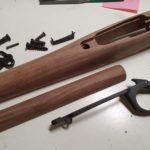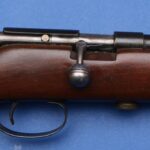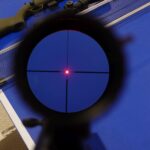Winchester Wildcat is the name Winchester uses for its bottom of the barrel, absolute garbage ammo. It’s also the same name they gave to a newly designed semi-auto 22LR rifle made by Silah in Turkey. Unlike the ammo, the rifle itself is super interesting and has more iterative innovations packed into it than any other 22 design I’ve seen in the last 10 years. Unlike many other semi automatic 22’s that aren’t that much better than the 1960’s designed Ruger 10/22, the Wildcat has some pretty compelling advancements built in. Wildcats go for around $300+ in Canada, and about $230 in the US.
Winchester Wildcat Basic Specs
- Semi automatic
- 10 round flush-fit mags
- Very lightweight: 4lbs
- 18″ barrel
- Bolt hold open, bolt release, and auto-bolt
Innovations in the Wildcat
- Compatible with Ruger 10/22 mags
- Extremely quick, tool-less disassembly that doesn’t suck
- Rear peep, front post iron sights with a long sight radius
- Forend picatinny rail for bipods
- A mag release that doesn’t suck
Disassembly
Disassembly on the Wildcat is the best of any popular semi automatic 22, period. You press in a button on the back of the receiver, pull down on the trigger guard, and the bolt+trigger assembly rotate out of the bottom of the action. You can quickly brush off the breech face, clean the bolt face and extractor, all the stuff that you’d need to do after running a thousand rounds of dirty 22 ammo through a rifle. Because of the access port through the back of the receiver, you can run a cleaning rod into the barrel from the receiver: which is preferred to over running rods in from the muzzle because you’re less likely to damage the crown. The way the trigger assembly is put together really reminds me of the Browning SA-22 and the Norinco JW-20 copy.

Attached to the trigger assembly are 2 allen keys. 1 size can be used for removing the barrel and receiver from the stock (not that you’d need to), while the other smaller key can be used for things like adjusting the rear sights. This small touch is so convenient! If you were out plinking and needed to make an adjustment to your sights, you could do it in about a minute with the tools provided.
Among other semi automatic 22’s, this is a radically better disassembly process for cleaning.
Mags & Mag Release
The Winchester Wildcat mag is lightweight (36 grams vs 56 grams on the 10/22 mag) and holds the bolt open after the last shot. It has a wheel on the back so you can remove follower tension and more easily load the mag. You can also use Ruger 10/22 mags in the Wildcat, though without the tensioner wheel or bolt hold open on the last shot. In my opinion, this is a good move because Ruger mags are everywhere and are easy to find.

The mag release is really interesting as well. You’ve got your choice between pulling two strips on the side of the stock back, or using a tab on the bottom. Using the two strips with a pinch grip and then pulling back is my favorite because it pops the magazine right into your hand. Magazine releases on many semi auto 22’s are pretty shitty, so it’s nice when you see one that is easy to use.
The other thing that’s flat out better than the Ruger 10/22 is that magazines spring out of the action. With the Ruger, you need the rifle uncanted or else mags will not come out. With the Wildcat, they pop out from any angle.
Sights & Rail
I really like long sight radius, rear peep+front post sight setups such as the ones on the M1 Garand and M14. For me, they’re the most accurate and quick to use: and many other people also prefer upgrading their Ruger 10/22, Marlin 795, etc to Tech Sights to get that rear aperture sight. While the Wildcat doesn’t have the easy adjustability of tech sights nor would it be as durable, it is very low profile and unobtrusive. In my opinion, the basic sights that the Wildcat comes with may be all you need.
If you opt to use an optic, know that:
- The rail is plastic. So it may not take a ton of abuse or work well with some scope mounts
- You’ll need a cheek riser or additional rest of some kind to use an optic effectively. The stock comb is made for using the irons
Other Nick-nacks
Most new, value-priced rifles use plastic sling studs molded into the rifle stock. For sling use, these are fine, but people run into trouble when they put a sling-stud based bipod on the front. Harris-style bipods can destroy the plastic attachment point if tightened too much or if you put too much torque on the bipod. The Wildcat 22 gets around this by having a stud AND a small section of picatinny rail on the front tip of the forend. You’re not going to wreck that bit of pic rail (even though it’s plastic) with a bipod.
There’s a bolt release on the left hand side of the action, but I can’t see why you’d bother using it when pulling back and releasing the bolt charging handle is easier. You can mod a Ruger 10/22 to “auto bolt” like this, but it’s nice that the Winchester just does it out of the box.
The bolt hold open is a nice big blade at the front of the trigger guard. Super easy to use.
Reliability across 1000 rounds that I’ve fired through it has been 100%.
Con: So much plastic
There are 3 downsides that I can see to the Wildcat:
- Accuracy is just so-so
- With so much plastic, durability in adverse conditions won’t be great
- Mag insertion is kinda crappy
Accuracy on mine was around 0.75-1″ groups at 50 yards. That’s not amazingly good accuracy but it’s serviceable, especially for hunting. I don’t think the design lends itself particularly well to being super accurate: the bolt runs on a single guide rod and bolt alignment is determined by a plastic plug at the back holding the trigger group in: which needs a bit of play by necessity. It’s not a high precision setup, but that’s OK. Not all guns need to be highly accurate, because a lot of the time we’re not shooting from a bench where we can use all that hypothetical accuracy anyways. Shooting off-hand, you’re going to be the accuracy limit, not the rifle.
The bigger downside may be the amount of plastic used in the construction of the rifle. Things like the magazine release mechanism and the rear sight use a LOT of plastic and may not be durable if you get rammy in cold weather. The tiny plastic rail cover on mine snapped after I took it off one time. The rear sight shot loose once, though after tightening it back on, it hasn’t done that again. To be fair, the rear sights on my $1300 CZ Shadow 2 were kinda loose from the factory as well.
Finally, and this bugaboo is on the Ruger 10/22 as well: mag insertion is kinda herky-jerky. Push up on the back, then front, you kinda wiggle the mag in. It’s not as nice as a straight push up into the magwell, and it can be frustrating for new shooters.
Use Cases & Summary
I really like how light this rifle is. The Mossberg Plinkster is light as well, but unlike the Plinkster, the Wildcat does not scream “cheap!” as loudly as the Plinkster does. The Wildcat is likely the rifle I’d hand to one of my boys if we were going out small game hunting because it’s lightweight, it has very functional iron sights, and they both loved shooting it. If we were going for gophers, I’d stick a bipod on the forend, maybe put a 2-7 or 3-9 scope on and a strap-on cheek rest as well.
At around $300 in Canada, it’s priced to compete directly with the Ruger 10/22 and I think for some uses, it’s a clear winner. If you want to upgrade your rifle later with aftermarket parts, the Ruger 10/22 still reigns supreme, but if you just want a lightweight, easy to use 22 rifle, the Wildcat is hard to beat.





